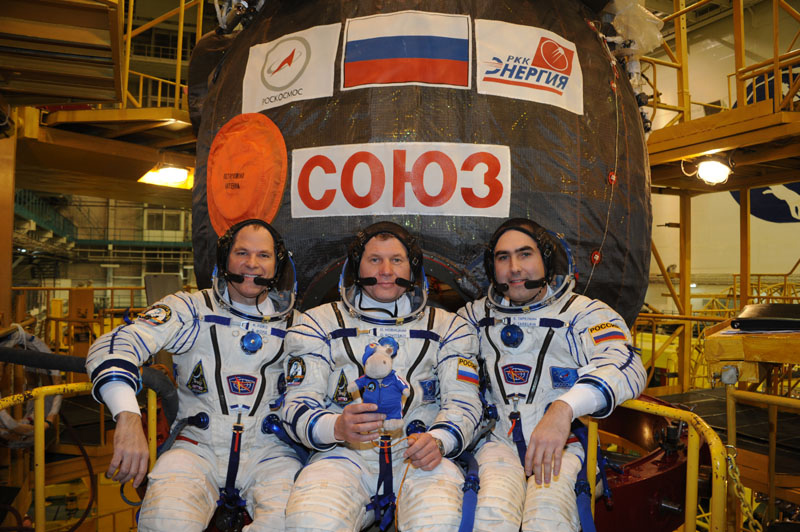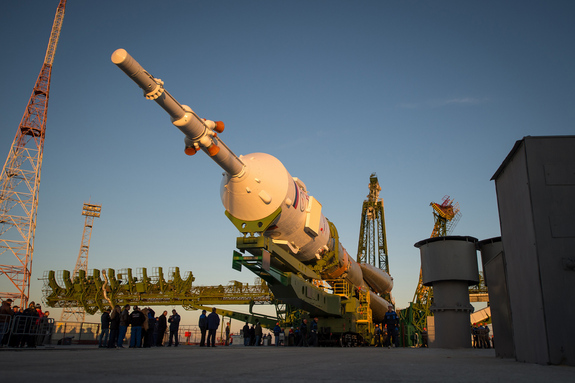Soyuz Rocket Launching US-Russian Crew to Space Station Tuesday

A Soyuz rocket is counting down to launch a new U.S.-Russian crew to the International Space Station on Tuesday (Oct. 23), a mission that will double the orbiting laboratory's population.
The Soyuz rocket will launch a three-man Soyuz TMA-06M spacecraft on a two-day trip to the space station from the Central Asian spaceport of Baikonur Cosmodrome in Kazakhstan. Liftoff is set for 6:51 a.m. EDT (1051 GMT).
American astronaut Kevin Ford and Russian cosmonauts Oleg Novitskiy and Evgeny Tarelkin will ride the Soyuz space capsule into orbit during the launch. The trio will arrive at the space station on Thursday (Oct. 25) and join three other astronauts currently aboard the orbiting lab.
"For me this is a very new adventure, launching from Russia and launching aboard a Soyuz," Ford, a veteran NASA space shuttle pilot, said in a prelaunch press conference. "The Soyuz is an amazing spacecraft."
Ford, Novitskiy and Tarelkin are launching on a five-month mission as part of the space station's Expedition 33 and 34 crews. It is Ford's second spaceflight and the first trip to space for Novitskiy and Tarelkin. Novitskiy will command the Soyuz trip to the space station. [Photos: Inside the Station's Expedition 33 Mission]
"It's going to be a wonderful experience to see them in orbit for the first time," Ford said.
You can watch the launch live on SPACE.com here via a NASA TV feed. The NASA broadcast will begin at 5:30 a.m. EDT (0930 GMT).
Sign up for the Live Science daily newsletter now
Get the world’s most fascinating discoveries delivered straight to your inbox.

Ford and his crewmates will join NASA astronaut Sunita Williams, Japanese astronaut Akihiko Hoshide and Russian cosmonaut Yuri Malenchenko when they arrive at the station on Thursday. The Soyuz flight comes at a busy time at the space station.
On Sunday (Oct. 28), a private Dragon space capsule will depart the space station to wrap up the first commercial cargo delivery for NASA. The Dragon capsule, built by the Hawthorne, Calif.-based company SpaceX, is flying the first of its 12 cargo missions for NASA under a $1.6 billion deal.
Next week, an unmanned Russian Progress cargo ship will launch toward the station. That flight will launch and dock at the station on Wednesday, Oct. 31, making it a Halloween delivery for the crew.
One day after the Progress arrival, on Nov. 1, Williams and Hoshide will venture outside the space station on a spacewalk to repair an ammonia coolant leak on a space station radiator.
Ford and his Soyuz crewmates also expect to be onboard the space station when another private American cargo ship, the Cygnus spacecraft built by Orbital Sciences in Virginia, makes its debut flight to the space station in early 2013. Orbital Sciences has a $1.9 billion contract with NASA for eight Cygnus cargo missions.
While NASA currently relies on Russia's Soyuz spacecraft to ferry astronauts to and from the International Space Station, the U.S. agency is supporting the development of new private space taxis to launch Americans into space. NASA retired its space shuttle fleet in 2011 after 30 years of service. [Russia's Soyuz Capsules Explained (Infographic)]
Here's a snapshot look at the new space crew launching on Tuesday:
Oleg Novitskiy: Novitskiy, 41, is a native of Cherven in the Minsk Region of Belarus and a lieutenant colonel in the Russian Air Force. He and wife Yulia have a teenage daughter, Yana. In addition to his military pilot experience (he has logged 700 hours in various aircraft) Novitskiy is a qualified paratrooper instructor and military diver. He joined Russia's Federal Space Agency as a test cosmonaut in 2007.
Kevin Ford: Ford, 52, is the only veteran spaceflyer on the Soyuz crew and first launched into space in 2009 as the pilot of NASA's space shuttle Discovery during the STS-128 mission. He spent nearly two weeks in space on that flight, which delivered 15,000 pounds of cargo to the International Space Station.
Ford hails from Montpelier, Ind., and is a retired U.S. Air Force colonel. He and wife Kelly have two children, Anthony and Heidi. Ford was selected to join NASA's astronaut corps in 2000. He has logged more than 4,700 hours in various aircraft and is a qualified test pilot, aircraft instructor and glider instructor.
Evgeny Tarelkin: Tarelkin, 37, joined the Russian Federal Space Agency's test cosmonaut ranks in 2003. He is a native of Pervomaisky in the Chita Region of Russia and is a lieutenant colonel in the Russian Air Force. Tarelkin and his wife Alla have two young daughters, Alisa and Anna. He has logged 307 flight hours in various aircraft, is a qualified paratrooper instructor and has performed 800 parachute jumps.
Ford will ultimately take charge of the space station as its Expedition 34 commander in mid-November, when Williams, Hoshide and Malenchenko are due to return to Earth. Three new crewmembers will join the Expedition 34 crew in late December.
The International Space Station has been staffed by rotating crews of astronauts and cosmonauts since 2000, when the crew of Expedition 1 first took up residency. Construction of the $100 billion space station began in 1998 and has been overseen by five different space agencies representing the United States, Russia, Europe, Japan and Canada.
Today, the space station is the size of a football field and has the equivalent living space of a five-bedroom home, NASA has said. It is the largest manmade structure in space.
Editor's Note: This story was updated at 7:20 p.m. EDT on Oct. 22 to correct the spelling of Oleg Novitskiy's name.
This story was provided by SPACE.com, sister site to Livescience.com. You can follow SPACE.com Managing Editor Tariq Malik on Twitter @tariqjmalik and SPACE.com on Twitter @Spacedotcom. We're also on Facebook & Google+.

Tariq is the editor-in-chief of Live Science's sister site Space.com. He joined the team in 2001 as a staff writer, and later editor, focusing on human spaceflight, exploration and space science. Before joining Space.com, Tariq was a staff reporter for The Los Angeles Times, covering education and city beats in La Habra, Fullerton and Huntington Beach. He is also an Eagle Scout (yes, he has the Space Exploration merit badge) and went to Space Camp four times. He has journalism degrees from the University of Southern California and New York University.











